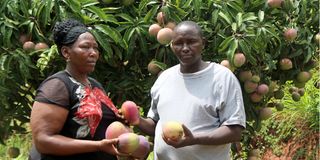Couple finds wealth in delicious apple mangoes

Teresia Wambua and her husband, Francis Mutuva at their farm in Makueni County. The farm hosts 300 mango trees.
What you need to know:
- Teresia, who runs the farm, says they began mango farming in 2003 by growing the local varieties, before they started grafting with the apple variety.
- Their purple colour appeals to consumers, according to Teresia, while the pulp is firmly attached to the fruit and has uniform yellow flesh.
- To plant the mango trees, she uses animal manure, at least 5kg for each and continues to apply regularly as the tree grows.
- Foliar fertilisers rich in potassium, nitrogen and phosphorus are then applied to enhance flowering and fruiting.
The sun is scorching hot as a Seeds of Gold team arrives at Teresia Wambua’s apple mango farm in Kithuiya village, a kilometre from Tawa market in Makueni County.
Sitting on an acre, the farm hosts 300 mango trees owned by Teresia and her husband, Francis Mutuva.
Teresia, who runs the farm, says they began mango farming in 2003 by growing the local varieties, before they started grafting with the apple variety.
“We found out that apple mangoes are sweeter and are loved by consumers and that is why we went for them. The mangoes have a diameter of about 10cm. These fruits are heavier and weigh between 200 and 500 grammes,” she offers.
Their purple colour appeals to consumers, according to Teresia, while the pulp is firmly attached to the fruit and has uniform yellow flesh.
Uses animal manure
“A retired chief introduced the hybrid apple mangoes in this region. He was the first to grow them and we saw they are well-adapted to the dry conditions of this area. Thus, the rest of us joined him by grafting our local varieties with scions from his trees,” she recalls, noting she invested Sh5,000 in getting the apple-mango scions.
To plant the mango trees, she uses animal manure, at least 5kg for each and continues to apply regularly as the tree grows.
Foliar fertilisers rich in potassium, nitrogen and phosphorus are then applied to enhance flowering and fruiting.
“Pruning should also be done between February and March every year to reduce branches and do away with those that may be infested with pests and diseases,” explains Teresia, whose trees are now mature.
Apple mangoes take three years to fully mature, unlike traditional varieties that take six.
“Flowering takes place between May and June and then the fruits begin to sprout at around November. In most cases, we harvest between January and February. The farmer can continue to harvest for 50 years, if the apple mango trees are well taken care of,” says Mutuva.
Use pheromone traps
They harvest once a year, getting 250-300 fruits from a single tree and sell each at Sh10 at the local market and Sh25 outside Makueni County.
“Some brokers normally buy from us and export the produce to India and China at a much higher price,” he says, noting they have used money from the fruits to comfortably educate their children.
Heavy rains that cause water-logging on the farm leading to diseases and fruit flies, which they use pheromone traps to eradicate, are some of the challenges they contend with.
Dennis Nyandaya, an agronomist and agricultural expert with Elim Agro Info, in Kibwezi, Makueni County, says a farmer should be aware of the kind of seeds to use and when grafting. This ensures that the mango tree continues to give viable flowers and fruits.
“During the early stages of development, it is important to use manure first before one starts to apply fertilisers that are rich in potassium, nitrogen and phosphorus to promote foliage and flower production. This takes place as the tree advances towards maturity,” he says
The flavour of the fruit depends on soil pH and fertiliser applied, he says.





